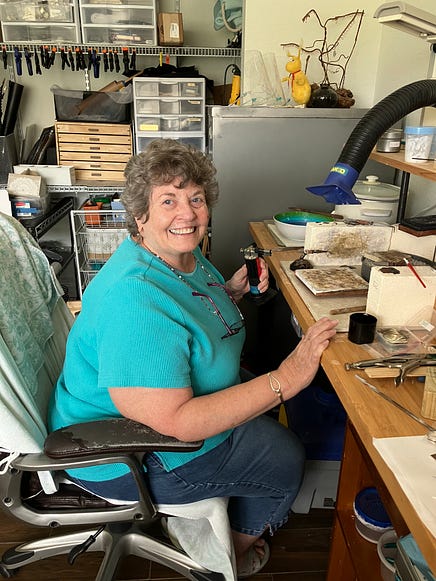|
 |
By Lyndi Schrecengost
This is the second article in a series on the growing number of Americans who are working past age 65. The first piece in the series gave an overview of the phenomenon, while the third piece will look at age discrimination in the workplace.
In “Mrs. McGinty’s Dead,” a novel by Agatha Christie, the famous Belgian detective Hercule Poirot bemoans his life in retirement, remarking to a friend: “Do you know what my biggest problem is? It is an abundance of leisure.” Poirot made this comment in 1952, yet it captures a central concern of retirees then and now ... what shall I do with my time?
On average, an American who retires at 65 can expect to live nearly another 20 years. So, today there is quite a lot more time to be had. But fortunately, as a baby boomer might say, the times they are a-changin’. Today’s “olders” are not waiting for their gold watch. Many are foregoing the golf course and the lounge chair for a different kind of retirement, responding to the challenge of what shall I do? with élan, intelligence and an intense desire to leave a legacy. In fact, many continue to work well beyond Social Security deadlines. Others don’t intend to ever stop, and they are busier than ever before.
Flexibility, Fulfillment ... and Fun
While growing numbers of older people want to continue to work past typical retirement age, they don’t want to work in the same way. As that arbitrary retirement cutoff looms, they begin to seek alternative work arrangements. They want to continue to work, but on their own terms. Yes, they want to spend more time with the grandkids and do a little traveling, but that’s not all. They want what might be called “the Three F’s” of work after 65—flexibility, fulfillment and fun.
For some, retirement provides an opportunity to pursue a dream deferred. Denny Machette Pizarro—a 72-year-old jewelry designer, metalsmith and teacher who lives with her sister Pat in Summerfield, Florida—did not have the luxury of pursuing her passion until later in life, and now she works as an artist for fulfillment rather than finances:
I was a very late bloomer and after I got a divorce, I went back to school, finished my undergraduate and graduate degrees and became a speech language pathologist. I had a young son to support, so I worked in that job until I retired. Then my sister, Pat (who is a quilter), also got divorced, and we decided that we could starve alone or we could pool our resources and maybe make a nice life for ourselves. And so that’s what we did.
Working from a guest bedroom in her house, Pizarro makes a small income from her business, but money is not what motivates her. She thrives on social interactions and staying connected with her community, particularly at Mt. Dora, her local artists co-op. “When I go to Mt. Dora, it feels like a day out. I come home tired, but I like meeting people, especially people who love art. I enjoy showing the work of other talented artists to people.”
In fact, fulfillment and fun are primary drivers for today’s older workers. Alain Bertaud, an 84-year-old urban planner formerly with the World Bank, had just returned from Brazil when he was interviewed for this article, and he was leaving for Europe a few days later. Having enjoyed a highly successful career, he continues to work a demanding schedule as a consultant, which takes him all over the world. He does it not for the money, but because he’s enjoying himself:
I have a good retirement income and I live a simple life. I don’t need money. I work because I enjoy it. For me, work is fun. Sometimes you deal with difficult people or problems, but in general, I find it is fun. I don’t conceive of stopping. When I visit a city as a tourist, I like to talk to people who are working on the planning of their city, to understand it better. My hobby became my profession, in a way.
Good for Body and Soul
There is growing evidence that staying in the workforce longer is not just good for one’s self-esteem and wallet; it is also good for overall health. The Journal of Epidemiology and Community Health published a 2016 study of approximately 3,000 people over an 18-year period. They found that working even one more year beyond retirement was associated with a 9 to 11% lower risk of dying. Another study published by the Centers for Disease Control and Prevention found that people who worked past 65 were nearly three times more likely to report being in good health and about half as likely to have serious health problems, such as cancer or heart disease.
The health benefits of continuing to work tend to track higher for educated, white collar workers, who have a greater level of financial security and more choice in pursuing a second career or consultancy work. If one’s job is physically taxing or overly stressful, like being a truck driver or nurse, continuing to work long, demanding hours can be detrimental to health. However, for most seniors, the benefits of staying in the workforce longer far outweigh any disadvantages. In addition to the financial, health and cognitive benefits already mentioned, older people who continue to work are much less likely to suffer from social isolation, substance abuse and neglect—conditions that have been especially prevalent for older Americans during and following the pandemic.
One key ingredient is that the work needs to be meaningful. When asked if he had concerns about the toll his work and travel might be having on his physical health, Bertaud responded: “Quite the opposite. It gives me a certain adrenaline. I enjoy seeing a new city—or visiting an old one—and interacting with young people. I think it maintains me in good health.”
Still in the Game but Playing It Their Way
As older workers approach retirement they begin to look for so-called bridge work—part-time employment, self-employment, contract or temporary employment. American Advisors Group surveyed 1,500 Americans aged 60 to 75 and found that almost half said they plan to work part-time or pick up a side job during retirement. And 12% don’t intend to ever stop working full time.
Whether the driving motivator is passion or profit, or both, today’s older employees want the freedom to choose their own projects and set their own schedules. This type of “phased retirement” and even the relatively new phenomenon of “encore retirement”—where older workers pursue entirely new careers after retirement—are redefining what retirement looks like today.
Liya Palagashvili, a senior research fellow at the Mercatus Center, notes that this desire for flexibility has greatly contributed to the new gig economy, where older workers are more likely to be independent contractors than in any other age group. “Your pre-platform, pre-Uber, independent work has long been the main source of income opportunities for retired or older workers who have moved past the traditional nine-to-five routine, but are open to transitioning to part-time or short-term work.”
One study showed that about 60% of nonworking seniors would be willing to return to work—in fact, would be eager to do so—if they had a flexible schedule. Study findings show that they are deterred, not because they are unwilling to work longer, but because they are unable to find acceptable jobs or don’t feel confident they will find them. These alternative work arrangements are most prevalent in the healthcare field, but embrace everything from nannying to substitute teaching to consulting.
Robert Miller, a former USAID employee-turned-consultant, comments: “I wanted to manage my own work schedule. I didn’t want to have someone else dictating how I spent my time. Although I was ready to leave my job, I knew that I wanted to do some volunteer work or maybe even teach. I couldn’t just lie around, eating bonbons all day and watching soap operas.”
Bertaud agrees: “I cannot be involved in something long-term, because at my age money is an inferior good compared to time. So, I’d rather have a short-term contract. I want to have my freedom.”
Leaving a Legacy
Most people think of legacy in terms of portfolio planning—providing for loved ones after our death. But today’s retirees are putting a new spin on legacy. For some, this means the values they pass on to their children and grandchildren. For others, it is leaving a positive footprint in the world that will pay dividends for others—as well as for themselves—for years to come.
Gil Williams and Susie Rheault, 85 and 75 respectively, were both of retirement age when they founded Precious Project, a nonprofit that provides educational and life skills opportunities for children in Tanzania. As Susie says:
I had traveled a lot in East Africa and I understood, at least at a beginner’s level, what was common across all these countries. Poor education was such a repetitive theme. But neither Gil nor I set out to build a school or get involved in education. We had just gone on a safari and were taking a walk with a hotel guide when we happened upon what was dubbed a new orphanage. It was this really hideous cinderblock house surrounded by not a single blade of grass. They didn’t have sanitation; they didn’t have clean, running water; they didn’t have electricity. They had nine kids sleeping in two beds and were running out of food chronically because they depended on the church locally for food handouts. We took one look at these kids who were just as cute as could be, jumping up and down and making faces for Gil with the camera, and we thought, “Gosh, this place could use a hand.”
Both Williams and Rheault had enjoyed successful careers, but wanted their retirement years to be about something more. Williams commented on what drove them to make Precious Project a reality: “I just decided I didn’t want to work for money anymore and I wanted to add more meaning to the work that I was doing.” Rheault, whose memoir, “My Wild and Precious Life,” recounts their experiences in Tanzania, added: “It’s hard to describe what this has done for us ... when we look back at some of the stuff we were doing with corporate America, it’s not in the same ballpark at all. No matter what happens with the project, we know that when we leave this world, we have a legacy that we built together with the Tanzanians. A life of meaning and purpose is hard to find and to create.”
Pizarro would agree: “I guess I feel fortunate that I still have the energy to pursue things and to be active. My health is relatively good and I think I would be bored out of my mind if I just was sitting around, going to this club or that club.”
Bertaud, whose work involves revitalizing and reimagining communities, is in turn revitalized by the young people he works with:
I am a little impatient sometimes with people my age, or even old friends. They talk about their health most of the time. I’m grateful to be around young people, who are full of ideas. When I was in Brazil, for instance, every night after work, I was invited to dinner, to go to a bar or cafe. I would talk with young people until midnight. For me, this is what is interesting, because they are full of dynamism.
The face of retirement will continue to change, but one thing won’t. As long as they are healthy, today’s “olders” will continue to want to work—and sometimes in ways they had never considered before. Susie Rheault sums it up well: “I never use the word ‘retired’ to describe myself. I wouldn’t, even if I was 102, because it just doesn’t describe our lives now that we’ve become totally involved with our project in Africa. It’s as difficult as anything else we’ve ever done and it’s challenging, but more importantly, seriously rewarding.”
You’re currently a free subscriber to Discourse .



